Smell-O-Vision Gaming: Enhancing Video Games Through Scent Technology
Updated On: August 24, 2025 by Aaron Connolly
What Is Smell-O-Vision Gaming?
Smell-O-Vision gaming takes AI tech and uses it to release scents that match what’s happening on your screen as you play. This adds another layer to your immersive experience, tossing in real-life smells like gunfire, rain, or forest air right alongside the visuals and sounds.
Origins of Smell-O-Vision
The whole Smell-O-Vision idea actually started in movie theaters back in the 1960s. Cinemas installed special gear to pump scents into the air to match the action on screen.
They wanted to make films feel way more real and engaging for everyone in the audience.
But honestly, the original Smell-O-Vision flopped. Scents often arrived late or just hung around too long. Some seats got blasted with smells, and others barely got anything.
A lot of people found the whole thing more distracting than immersive.
Movie studios ditched the tech after only a few years. Still, the concept stuck around. Engineers and inventors kept tinkering with scent-based entertainment for decades.
Adapting Smell-O-Vision for Games
Modern Smell-O-Vision in gaming works pretty differently from the old cinema trick. Devices like GameScent use AI to listen for audio cues from your game in real time.
When the system picks up certain sounds, it releases matching scents automatically.
These gadgets are small boxes that hook up to your PC, console, or VR headset. You connect them through HDMI ports or audio jacks.
They use swappable cartridges filled with different scents:
- Gun Fire
- Explosion
- Racing (burning rubber)
- Storm (rain)
- Forest (pine, earth)
- Clean Air (neutraliser)
The AI listens for patterns that match these scents. If you hear gunfire in a shooter, you’ll smell gunpowder. Rain sounds? The device releases a storm scent.
A Clean Air feature helps clear out leftover smells after your session.
Memory and Emotional Impact of Scent
Our sense of smell connects straight to the brain areas that handle memory and emotion. That’s why scent-based gaming might stick with you more than just visuals and audio.
Studies even show that smells help form stronger long-term memories than other senses do.
Gaming companies see this as a way to make virtual worlds feel more real and emotionally charged.
The goal is to hit all five senses during gameplay. Since scent can mess with taste, too, this tech could offer deeper immersion than we’ve ever had before.
Right now, these devices cost about £120 to £150. That’s not cheap, but it’s within reach for gamers who really want to try it. You can usually test the tech at conventions before buying.
How GameScent Works
GameScent uses AI to pick up game sounds from your audio feed and then triggers the matching scent from its cartridges, all in real time. The device listens to what’s happening in your game and releases the right smell within seconds.
AI-Powered Audio Detection
GameScent grabs your game’s audio signal through an HDMI transmitter. You stick the device between your console, PC, or TV and your screen.
The transmitter streams your game audio to GameScent’s online servers, so you’ll need to keep the device online.
GameScent’s servers run a PyTorch-based machine learning system with a big library of sound effects. The AI matches your game’s audio to its database as you play.
When it hears familiar sounds like gunfire, rain, or forest ambience, it sends a signal back to your GameScent box. The company says it hits about 85% accuracy for detecting game sounds.
Honestly, the audio detection works best when the sounds are clear and not muddled with too many overlapping effects.
Swappable Scent Cartridges
GameScent uses six numbered slots for individual scent bottles. Each bottle packs enough liquid for about 5,000 bursts.
The starter kit includes:
- Forest
- Gunfire
- Explosions
- Racing Cars
- Storm
- Neutralising scent (to clear the air)
Just drop the glass bottles into the slots and pop the atomisers on top. You can use the GameScent app to assign each scent to a slot.
Upcoming scents will include Blood, Fresh Cut Grass, Ocean, and Sports Arena. If you want, you can try other essential oils if they fit the bottles, or clean out empty bottles for your own blends.
Real-Time Scent Release
When GameScent hears the right audio, it releases the scent in just a few seconds. The device can trigger more than one scent, depending on what’s happening in your game.
During Far Cry 6 testing, GameScent noticed forest sounds and sent out a woody scent almost right away. It also caught gunfire and released that smell, too.
Just a heads-up: The HDMI transmitter doesn’t support variable refresh rates and probably tops out at 4K/60fps unless you have eARC.
You can get around this by using your TV’s optical or 3.5mm audio output. GameScent is already working on new transmitters with optical audio ports to fix this.
The app also lets you manually trigger scents if you want total control over when smells are released.
Compatible Devices and Set-Up
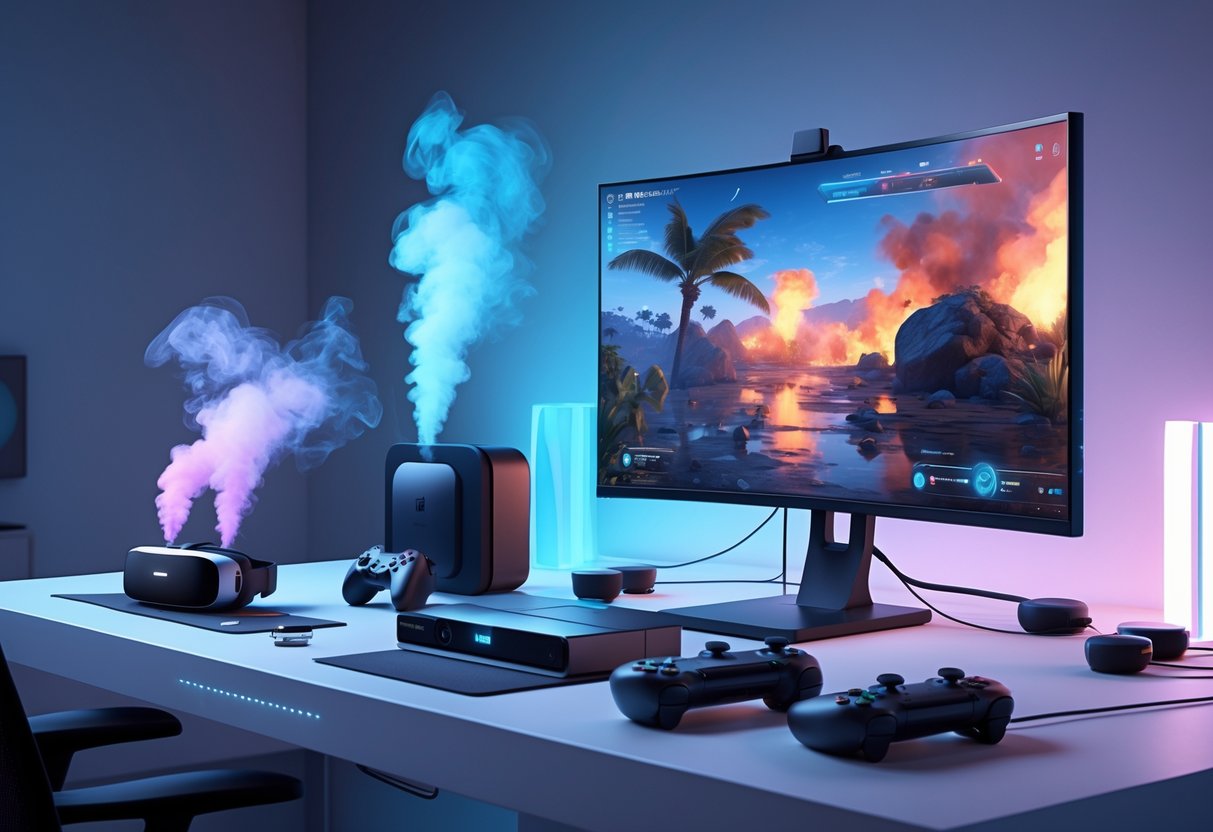
GameScent works with pretty much every gaming platform you might have. You connect it through HDMI and audio inputs, so adding scent to your setup isn’t complicated.
Connecting to Consoles
GameScent hooks up to all major gaming consoles using its HDMI adapter. Plug your console’s HDMI cable into the GameScent box, then run another HDMI cable from the box to your TV or monitor.
This setup works the same for PlayStation, Xbox, and Nintendo Switch. Your console sends video and audio through the GameScent, which processes the audio for scents.
Key Connection Points:
- HDMI input from console
- HDMI output to display
- Power cable to mains
- Scent cartridge slots
The device sits between your console and screen but doesn’t mess with video quality or add any noticeable input lag. Most users say the connection process takes under five minutes.
Integrating with PC and VR
PC gamers can use the 3.5mm analogue audio input instead of HDMI. This lets GameScent read audio from your computer while your monitor connects straight to your graphics card.
For VR, you just use the headset’s audio output. GameScent picks up spatial and environmental sounds to match scents with whatever’s happening in your virtual world.
PC Setup Options:
- Direct audio line from sound card
- USB audio adapter connection
- Headphone splitter for shared audio
The AI keeps up with about 85% accuracy across different games and platforms. You’ll need to download the GameScent app to set up your scent preferences and connection details.
Essential Accessories
You get an HDMI cable and power adapter with the GameScent device. Scent cartridges are separate and come with different fragrance combos for various game vibes.
Included Items:
- GameScent main unit
- HDMI input/output cables
- 3.5mm audio cable
- Power supply
- Quick start guide
Additional Purchases:
- Scent cartridge refills (£15-25 each)
- Extra HDMI cables for more consoles
- Audio splitters for tricky setups
The device sells for £149.99 on Amazon right now, down from £179.99. Replacement scent cartridges last about 40 to 60 hours, depending on how much you play.
Key Scents and Customisation

GameScent devices come with a set of carefully chosen base fragrances to fit the most common gaming scenarios. More scent packs are on the way to give you even more options for different game genres.
Base Scents Included
Most smell-o-vision gaming hardware arrives with six to nine core scents that cover the usual gaming environments. These usually include gunfire, forest (fresh-cut grass), storm, ocean, and explosion fragrances.
GameScent’s library also has more specific scents like napalm, blood, human exertion, and big city air. The gunfire scent tries to nail that sharp, smoky smell you’d get in a firefight.
Forest levels trigger fresh-cut grass aromas when you’re wandering through the wilderness. Storm scents kick in during weather effects or dramatic scenes.
Clean Air mode clears out all lingering smells between sessions, so your room doesn’t end up smelling like a war zone after you’re done.
The device’s AI listens for in-game audio cues and releases the right scents automatically. No need to fiddle with it in the middle of a match.
Upcoming and DLC Fragrances
Manufacturers are planning to roll out genre-specific scent packs as downloadable content for all kinds of games. Racing games might get burning rubber, fuel, and tyre smoke.
Horror titles could bring in cemetery earth, musty dampness, or decay to ramp up the creepiness. Fantasy games might offer magical forests, dragon’s lairs, or ancient dungeon smells.
Sports packs could recreate stadiums with crowd sweat, grass, or even locker room vibes. City-building games might throw in construction dust, traffic fumes, or seaside pier scents.
Seasonal scent releases might drop alongside big game launches or updates. In the future, you might get to mix your own custom scent profiles for your favourite games.
The tech supports up to 255 different scent combos, so there’s a lot of room for expansion beyond the basics.
Immersion and Sensory Enhancement in Gaming
Gaming tech is pushing way past screens and speakers these days, aiming for full-on multi-sensory experiences. Haptic feedback, scent systems, and synced gameplay elements are changing how we dive into virtual worlds.
Haptics and Other Sensory Technologies
Haptic feedback is the big one for sensory gaming right now. Sony’s DualSense controller, for example, uses advanced tactile responses so you can actually feel raindrops, gunshots, or the rumble of an engine.
Touch-based tech isn’t just for controllers anymore. VR headsets now work with full-body haptic suits that simulate physical sensations all over. These suits use a bunch of contact points to create realistic feelings of impact, temperature, and movement.
Audio enhancement is a huge deal for immersion, too. 3D spatial audio puts sounds right where they should be, so footsteps behind you actually feel threatening. When you mix that with haptics, you get some seriously convincing effects.
Now, scent technology is stepping up. Companies like GameScent use AI to spot game events and release the right smells from a little desktop device. You can actually smell gunpowder in a shootout or fresh forest air while exploring.
Visuals still matter, of course. High refresh rate displays and HDR tech make images smoother and more vibrant, reacting instantly to whatever you do.
Synchronising Scent with Gameplay
To match scents with gameplay in real time, AI systems have to recognise visual and audio cues from games. They watch for on-screen elements like fire, water, or combat, then trigger the right scent within seconds.
Most scent devices rely on cartridge systems, usually offering 6-9 different smell categories. Gunpowder, forest, storm, fire, and ocean seem to be the most popular options. You plug these devices in via USB, and they just work—no special game programming required.
Getting the timing right really matters. If there’s more than a 2-3 second delay, the whole effect falls flat. Sony’s latest systems, for example, process visual data almost instantly to keep everything in sync.
You can control how strong the scent gets, which is handy. Too much and it’s overpowering, too little and you barely notice anything. Most devices let you pick from 3-5 intensity levels.
Game companies are also looking at pre-programmed scent tracks, kind of like musical soundtracks. These would roll out scents at exactly the right moments for each game, giving more precise control than AI alone.
Smell-O-Vision in Popular Games
GameScent lets you actually smell everything from gunfire to forests in all sorts of games. It uses AI to analyse what’s happening on screen and then releases matching scents.
First-Person Shooters
First-person shooters deliver some of the most intense scent effects. When you fire a weapon in games like Call of Duty or Counter-Strike, GameScent pumps out a gunfire smell to match the action.
The explosion cartridge kicks in for grenade throws or rocket launches. This really amps up the sensory experience and makes firefights feel more real.
Available FPS scents include:
- Gunfire
- Explosion
- Clean Air (to clear battle smells)
The AI watches for muzzle flashes and blast effects, then releases the scent at just the right moment. Some players say these smells make matches way more immersive.
But honestly, the gunfire scent can get a bit much after long sessions. It’s a good idea to swap in the clean air cartridge between rounds to give your nose a break.
Racing Games
Racing games get a boost from GameScent’s racing cartridge. That one mimics burning rubber and exhaust fumes. In Forza and Gran Turismo, tire squeals and engine revs trigger these scents.
The device looks for visual cues like tire smoke or engine backfires. This creates a racing atmosphere right in your living room.
Stormy weather in racing games sets off the storm scent. Rainy tracks and lightning effects flip this cartridge on automatically.
Developers might add fresh-cut grass scents for countryside circuits in the future. Honestly, racing feels more authentic when your nose gets in on the action too.
Adventure and Open-World Titles
Open-world games probably offer the widest range of scents. The forest cartridge pops on when you wander through the woods in The Witcher 3 or Red Dead Redemption.
Weather changes trigger different smells automatically. Thunderstorms bring out storm scents, while peaceful meadows might just use clean air.
Upcoming scents for adventure games:
- Ocean (for exploring coasts)
- Fresh-cut grass (for rural areas)
- Blood (for combat)
The Last of Us players can now smell that post-apocalyptic world. The AI notices when you enter new environments and swaps cartridges as needed.
At £149.99, GameScent makes this kind of immersion possible for a lot of gamers. Swapping cartridges lets you pick which scents work best for your favourite games.
Cross-Platform Applications Beyond Gaming
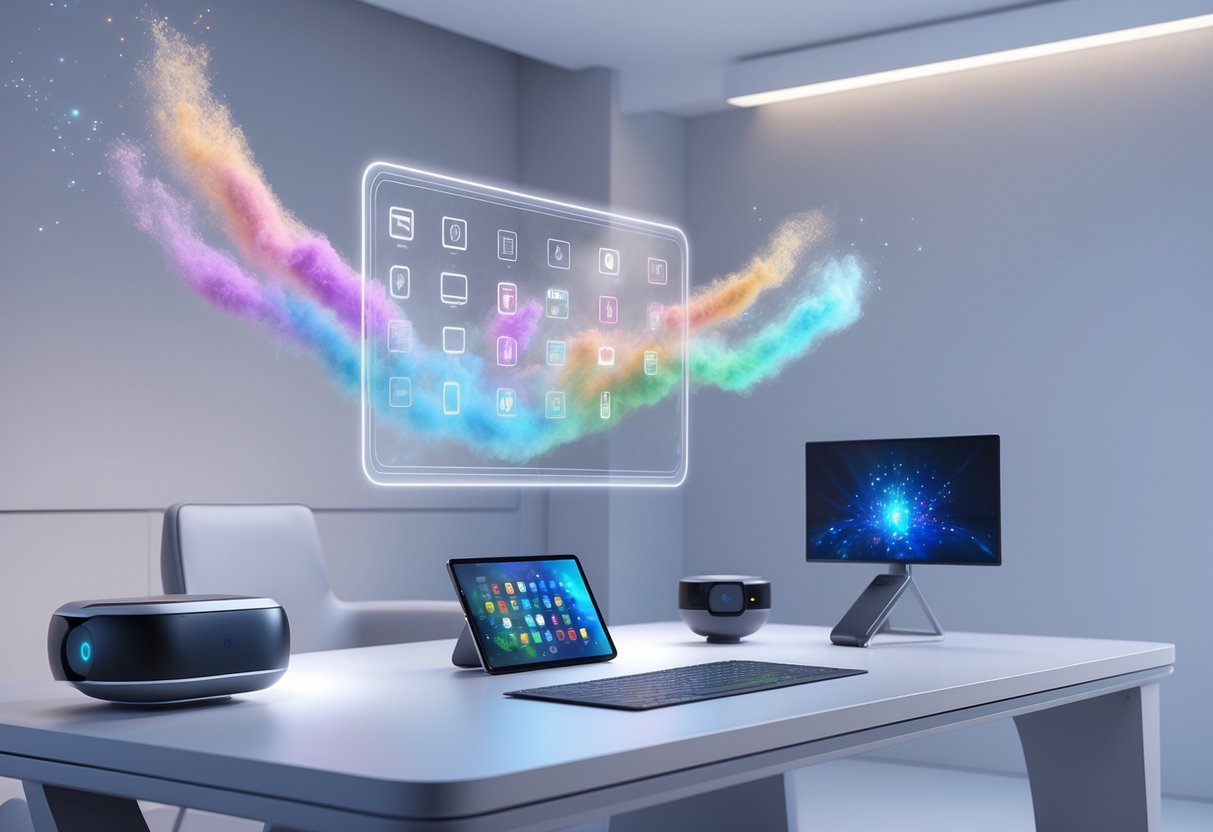
Smell-O-Vision isn’t just for games anymore. It’s starting to pop up in films and live events too, using the same scent-release tech to create immersive experiences across all sorts of media.
Movies and TV Integration
Cinema chains have started testing scent systems that sync with movie soundtracks. The tech works a lot like GameScent, picking up audio cues to release the right fragrance.
Some streaming platforms are getting into the act, exploring home scent devices. These little machines connect to your TV and release smells during big scenes.
Theatre productions have jumped on board, using scent tech for live shows. They can fill the space with forest or ocean smells, depending on the scene.
Cost considerations are all over the place:
- Cinema installs: £10,000-50,000 per screen
- Home devices: £200-500
- Theatre systems: £5,000-20,000
Heads up: Many home scent devices need pricey refills—£15-30 each.
The biggest headache is timing accuracy. Movies move faster than games, so keeping scents in sync is even harder.
Virtual Events and Experiences
Virtual reality experiences now sometimes include scent for training. Medical students, for example, might smell antiseptic during surgery simulations.
Online conferences have tried sending out scent boxes to attendees. These little devices release smells during presentations about food, nature, or manufacturing.
Virtual tourism lets you smell places as you explore online. Museums might mail out scent kits to go with their virtual tours.
Corporate training uses scent to teach safety. Workers can smell gas leaks or chemical hazards in virtual environments, all without actual risk.
Popular uses include:
- Remote wine tastings with aroma samples
- Virtual cooking classes with real ingredient scents
- Historical recreations with period-accurate smells
These cross-platform uses run into the same problems as gaming: cartridge costs and keeping devices working.
Consumer Reception and Market Adoption
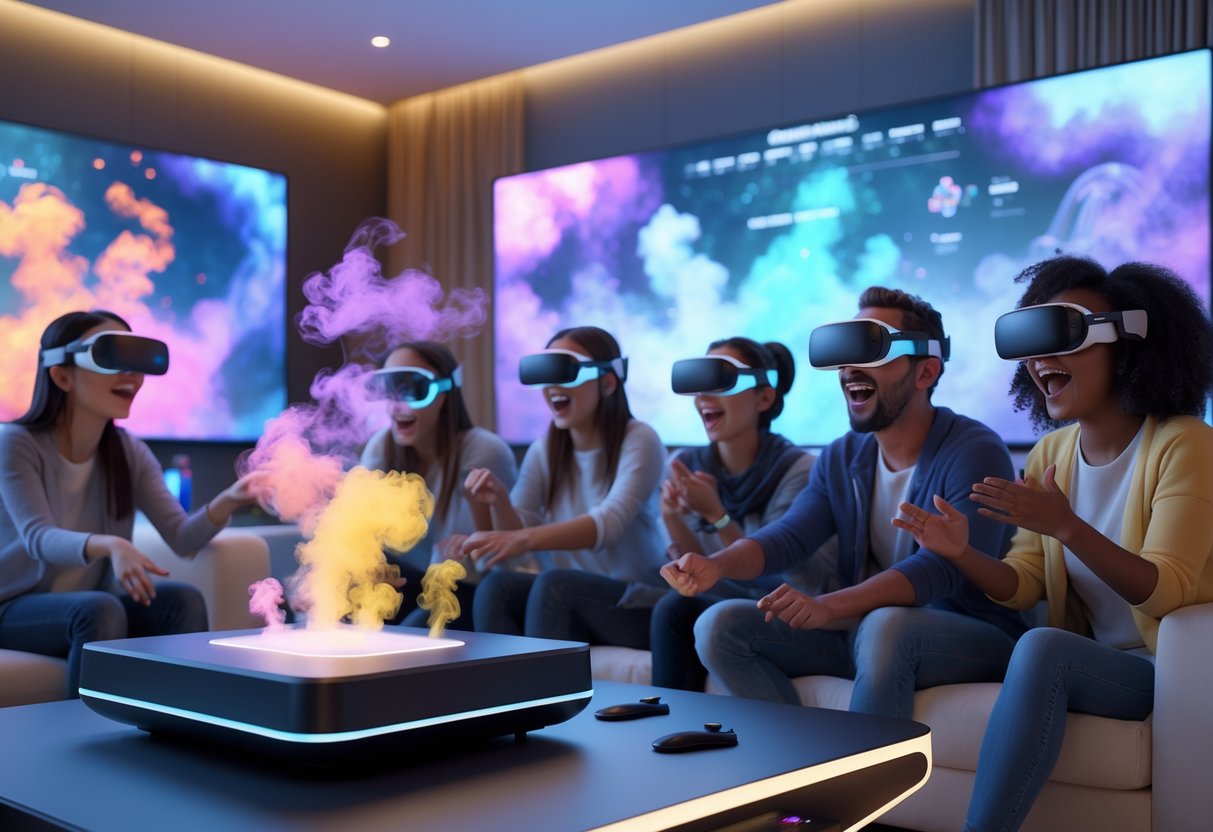
Gamers haven’t fully embraced smell-o-vision yet. Devices like GameScent are out there, but most companies still seem to be testing the waters.
Retail Availability and Pricing
GameScent stands out as one of the first consumer-ready smell-o-vision devices for gaming. It debuted at gaming trade shows and even showed up at the Consumer Electronics Show.
You can pick one up for about £150-200. It connects to gaming systems and releases scents during gameplay. Big plus: it works with popular titles and across different platforms.
Where to get it:
- Direct from the manufacturer’s site
- Some electronics retailers
- Gaming shops in a few regions
Most other smell-o-vision tech is still in the prototype stage. Sony showed off its Future Immersive Entertainment Concept at CES 2025, but that’s not something you can buy for home. That setup fills a whole room with LED screens and scent delivery—it’s meant for arcades or gaming centres.
User Experiences and Reviews
Early adopters have mixed feelings about smell-o-vision. GameScent gets points for being fun at parties, but people complain about a limited scent selection and timing hiccups.
Common feedback:
- Positive: It’s a cool party trick, works best with certain genres
- Negative: Not enough scent variety, sometimes delays, scents can be too strong
Some gaming communities are skeptical about mixing smell with games. When Sony demoed The Last of Us with scent, players wondered if smelling a ruined world really adds anything.
Plenty of gamers stick with tried-and-true immersion—better graphics, haptics, that sort of thing. Smell tech still has to prove it’s more than just a novelty.
Reviewers point out that these devices shine most with cooking or nature games, not so much with action titles.
Technical Challenges and Limitations
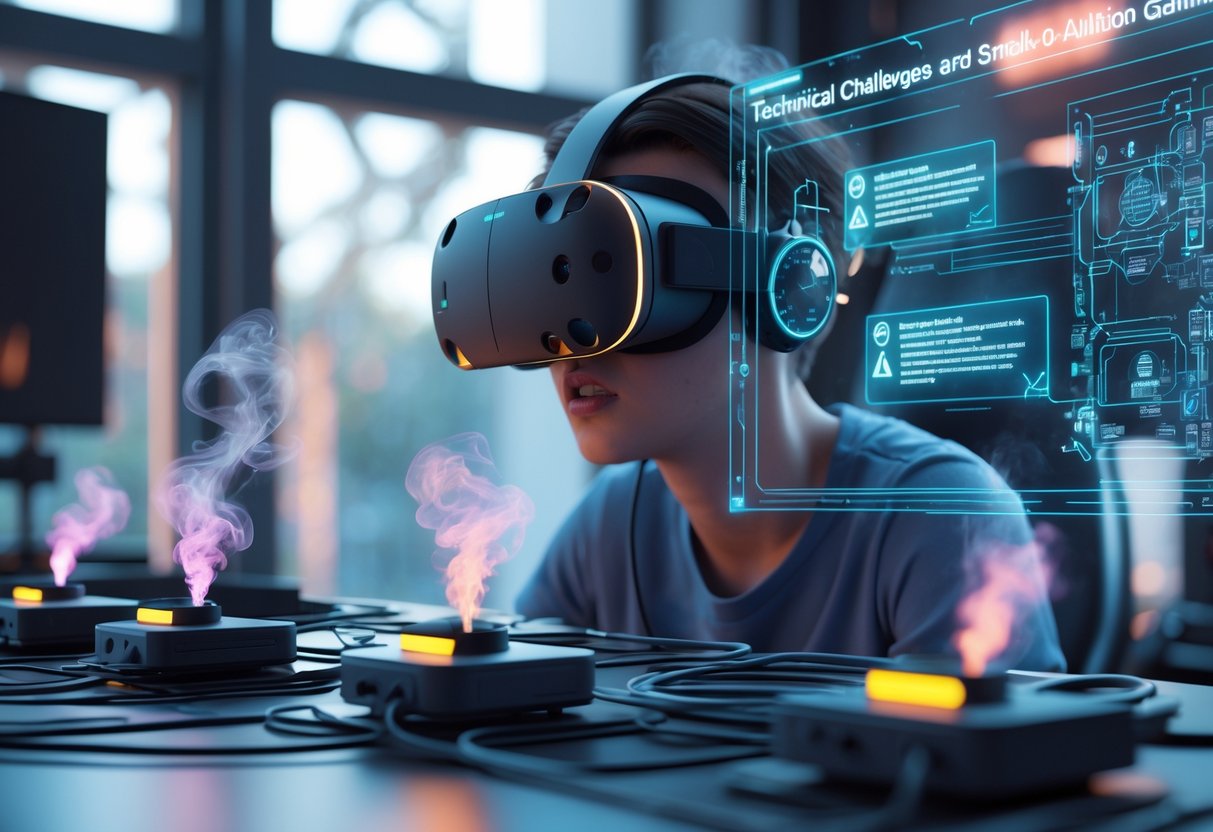
Game scent systems have some big hurdles to clear before they go mainstream. The main issues are timing and dealing with lingering smells in shared spaces.
Latency and Synchronisation
Matching scents to game actions is tricky. Most machines need 2-3 seconds to release a fragrance, so the smell of gunfire often hits after you’ve already fired.
Software integration makes things even tougher. Devices like GameScent need to talk to game engines through custom APIs. Every game needs its own setup to trigger scents at the right moments.
The hardware doesn’t always keep up. Scent cartridges use fragrance oils that need to be atomised into a fine mist. These steps just can’t match the instant feedback we expect from visuals or sound.
Network latency only makes it worse in online games. If your internet is laggy, scent timing drifts even more. A 100ms ping plus a 2-second scent delay means you get the smell over two seconds after the action.
Room Scent Neutralisation
Switching between scents without mixing them up is a real challenge. If a forest smell follows smoke, you sometimes get a weird combo instead of a clean transition.
Most devices don’t really clear the air between scents. They just stop releasing new smells, so the old ones hang around and muddy things up.
Room ventilation changes everything. Good airflow can clear scents too fast, while stuffy rooms can make smells build up and get overwhelming. Everyone’s nose is different, so it’s tough to find an intensity that works for everybody.
Scent cartridge cross-contamination happens too. After a while, the inside of the device gets coated with residue, and the smells start to blend together in ways you probably didn’t want.
History and Evolution of Scent Technologies
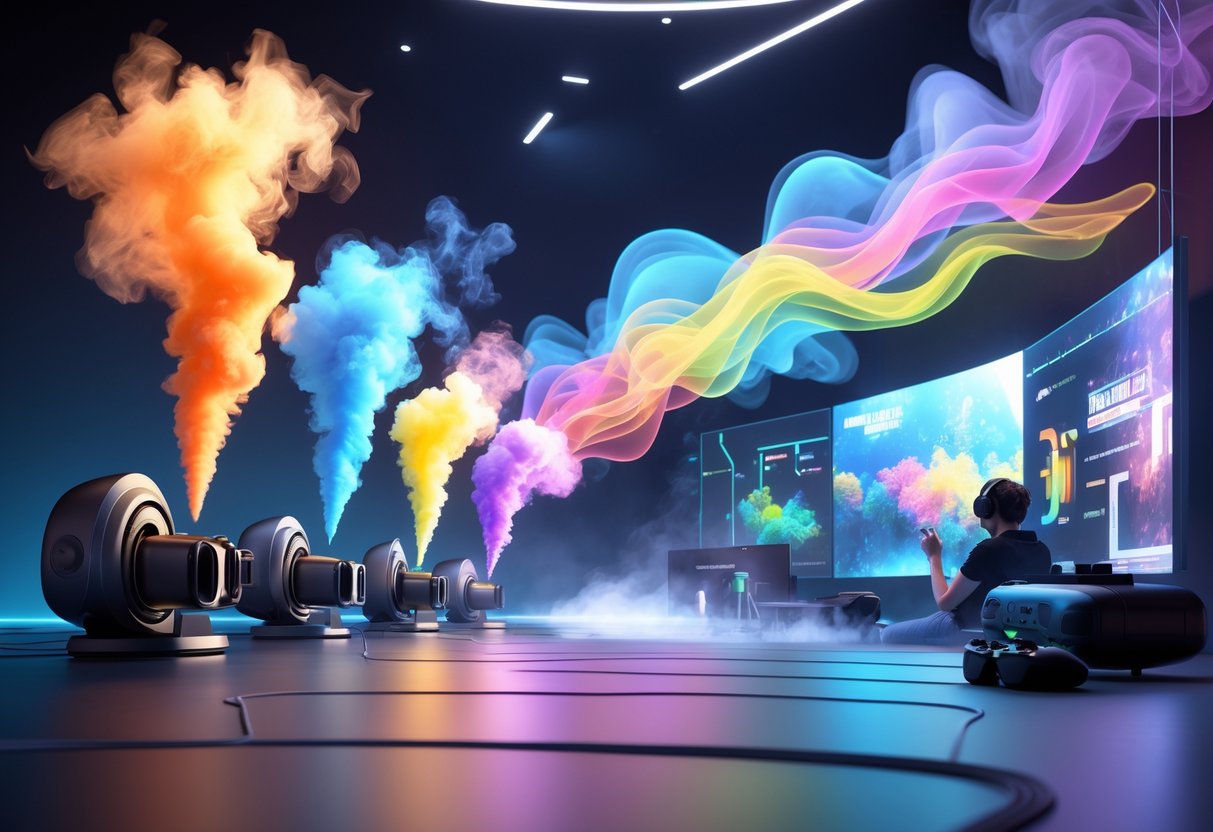
Scent tech in entertainment has come a long way in over 60 years of innovation. What started as simple theatre tricks has evolved into digital systems that can recreate thousands of smells.
Early Experiments in Cinema
Smell-O-Vision first appeared in 1960 with “Scent of Mystery.” Theatres piped different scents through the air conditioning. Each seat had its own scent tube that released smells at certain moments.
This tech ran into big problems. Scents lingered way too long, and not everyone in the audience got the same effect. It was also expensive and a pain to maintain.
Scratch and Sniff cards took over in the 1980s. Cinemas handed out cards with numbered scent patches. When a number popped up on screen, you scratched that patch.
John Waters used this for “Polyester” in 1981. The Odorama cards had 10 scents—some nice, like roses, some nasty, like dirty shoes.
These early efforts taught us a few things. Timing matters. Individual control beats filling a whole room. And if it’s not affordable, nobody’s going to use it.
Digital Scent Devices Like iSmell
The iSmell device launched in 1999 by DigiScents. It was a little desktop unit that plugged in via USB and could produce over 100 scents using oil cartridges.
It heated and mixed oils to create new smells. Websites could trigger specific scents with special code, and games could add smell effects to explosions or environments.
DigiScents raised a lot of money and demoed at CES. Retailers like Sharper Image planned to sell it for about £200.
But the company folded in 2001. The cartridges cost too much, and people didn’t love the synthetic smells. The device just wasn’t reliable enough for the mainstream.
Other companies tried similar things—Trisenx had the Savour, and ScentSciences made the ScentDome. They all ran into the same problems.
Recent advances have fixed some old issues. Modern devices use better scent chemistry, wireless connections instead of USB, and AI for smarter timing.
Future Prospects for Smell-O-Vision Gaming
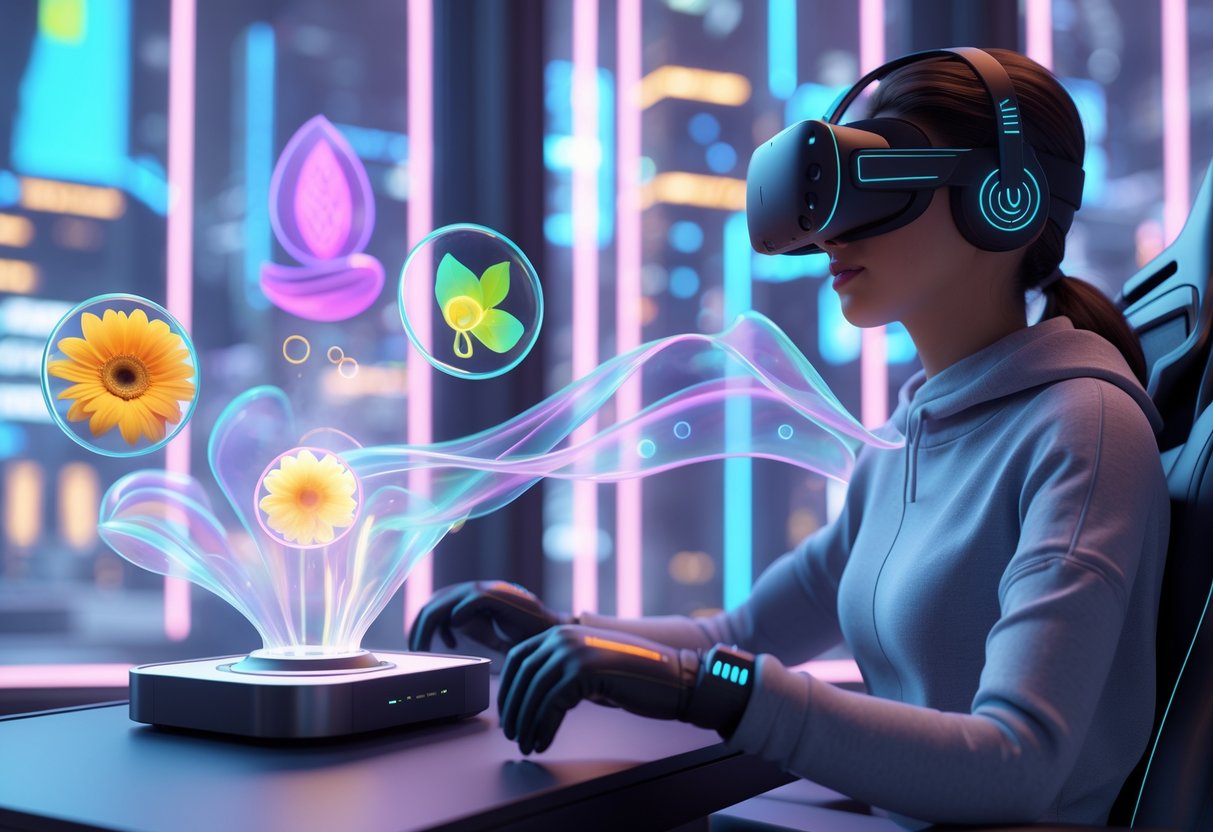
Gaming companies are actively building new scent tech that could change the way we play. Big tech firms are filing patents and showing off prototypes, all aiming to bring smell into interactive entertainment.
Emerging Innovations
Sony rolled out their Future Immersive Entertainment Concept at CES 2025. This room-sized setup throws you into a cube-shaped booth lined with LED screens and even uses scent tech for a full sensory gaming blast.
They combine Crystal LED panels with haptics and atmospheric effects. When you step inside, you get smells, visuals, and audio all at once.
Back in 2021, Sony filed patents for scent-based gaming. Their DualSense controller already packs haptics and audio, so adding smell feels like a natural next move.
GameScent takes a different route for home gamers. This AI-powered device uses scent cartridges that kick in during gameplay. It detects what’s happening in-game and releases matching smells.
The tech isn’t without its headaches. Game developers have to design scent features that actually add to the experience instead of just distracting. Cost is another hurdle that slows down wider adoption.
Current prototypes stick to straightforward scents—gunfire, weather, and basic environmental stuff. As the tech matures, maybe we’ll see a bigger variety.
Collaborations and Industry Growth
Gaming hardware makers are teaming up with scent tech companies. They want to weave smell systems into existing setups.
Sony’s method needs dedicated gaming centres, not home setups. Sure, that limits who can try it, but it lets them use more advanced scent delivery.
GameScent goes after individual gamers with plug-and-play gear. Their cartridge system keeps things simple for home use—no need to overhaul your hardware.
The industry really needs developers on board for scent features to take off. Studios have to code in scent triggers right alongside graphics and sound.
Arcades and other entertainment venues seem interested early on. These places can justify spending more for premium scent systems.
Patent filings hint that other big gaming companies are working on similar tech. That competition might speed things up and drive prices down.
Comparing Smell with Other Sensory Experiences

Gaming tech isn’t just about sight and sound anymore. Smell-o-vision devices are popping up, and researchers are tinkering with taste simulation via electrical pulses. Haptic feedback keeps evolving in games and even movies.
Taste Simulation in Digital Media
Researchers like Nimesha Ranasinghe at the University of Maine are building devices that send electrical pulses to your tongue. These pulses mimic tastes like salty, sweet, sour, and bitter.
The system targets specific taste receptors. You get realistic sensations without actually eating or drinking anything.
Ranasinghe’s team also made a “virtual cocktail” system. It lets people share digital drinking experiences.
This goes beyond gaming. VR experiences could let you “taste” food or drinks during virtual dinner parties.
Right now, these devices only handle basic tastes. Complex flavours like chocolate or coffee are still out of reach.
The Role of Touch, Sound, and Sight
Haptic feedback stands out as the most advanced extra sense in gaming. Controllers like the PS5 DualSense pump out vibrations for things like gunfire and explosions.
Sound design has gotten seriously impressive. Games use 3D audio to help you find enemies or move through virtual worlds.
Visual tech leads the pack. 4K displays, HDR, and VR headsets deliver sharp, realistic graphics that anchor the whole experience.
Movies have played with sensory extras for ages. 4D cinemas throw in moving seats, water sprays, and scents for big action scenes.
Syncing all these effects is tricky. GameScent uses AI to match scents with audio cues, while haptics need to hit at just the right moment with visuals or the illusion falls apart.
Frequently Asked Questions
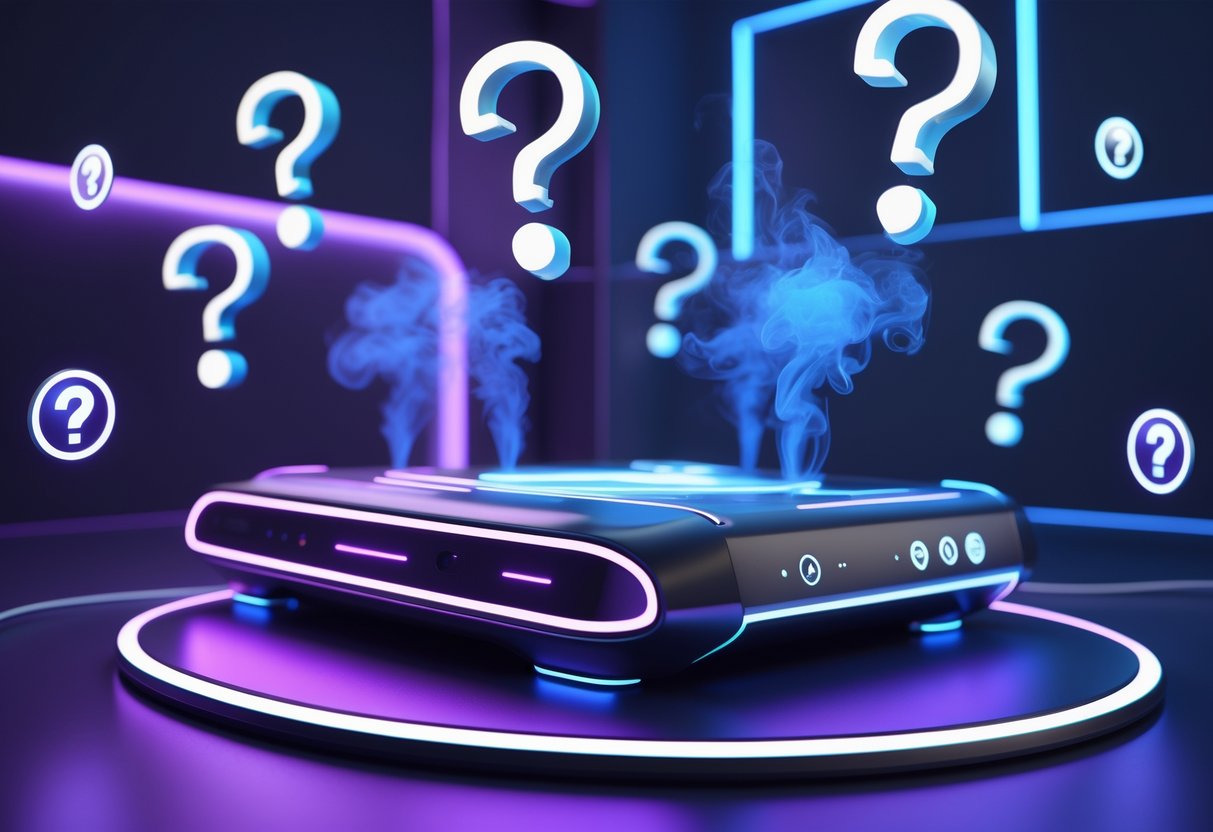
GameScent and other smell-o-vision gadgets are still pretty new, so gamers have a lot of questions—setup, compatibility, where to get extra scents. Here’s what we’ve figured out so far.
How do I set up my new game scent device for the ultimate immersive experience?
Most gaming scent devices plug in via USB to your PC or console. You’ll need to grab the companion app and put the device near your setup.
The AI listens to your game’s audio in real time to trigger scents. No special mods required.
Keep the device within two metres of your gaming chair. Scents work best in small rooms with less airflow.
Start with low intensity. The default setting can be a bit much, especially if you’re playing for hours.
Where can I purchase additional scent cartridges for my gaming scent system?
Right now, you’ll mostly find scent cartridges on the manufacturer’s official website. GameScent sells cartridge bundles directly.
Third-party sellers haven’t jumped in yet. Maybe Amazon and others will stock refills as the tech gets more popular.
Each cartridge lasts about 2-4 hours of active play. If you game a lot, grabbing multi-packs makes sense so you don’t run out mid-session.
Prices swing between £15-30 per set. Not exactly cheap if you want to use them regularly.
What are the latest reviews saying about the game scent technology?
Early reviews are all over the place. Some call it a fun novelty, while others say it’s not essential gaming gear. The tech does what it promises, but scent accuracy varies game to game.
A few reviewers love it for horror games or racing sims. Others find the scents distracting or not quite matching what’s on screen.
The AI sometimes fires off the wrong scent during cutscenes or menus, which kind of kills the vibe.
Most tech reviewers recommend waiting for the next generation. The current models need more polish before they’ll go mainstream.
How compatible is the gamescent app with current gaming platforms?
GameScent works with PC games on Windows 10 and 11. It reads your game’s audio, so it’s compatible with most titles.
PlayStation and Xbox support is spotty. The device can catch some audio from console games, but accuracy drops off.
VR headsets like the Apple Vision Pro aren’t supported yet. The GameScent crew hinted at possible future updates.
Mobile gaming isn’t on the table. The AI needs more audio processing power than phones can handle for now.
Can you list some of the most popular scents used in gaming and movie experiences?
Gunfire and explosions show up a lot in FPS games, though they smell more like fireworks than real gunpowder. Racing games trigger petrol and burnt rubber.
Forest and nature scents fit well in RPGs and adventure games. These usually smell the most realistic and pleasant.
Storm and rain scents build atmosphere in lots of games. Horror titles go for musty, damp smells to ramp up the tension.
Food scents pop up in cooking games and some RPGs. Honestly, these are hit-or-miss—some just smell fake or unappetising.
What should I do if my game scent device isn’t working properly?
Start by checking your USB connection. Go ahead and restart the companion app too. Honestly, most problems come from software glitches, not the hardware itself.
Try cleaning the scent chambers with a cotton swab. Sometimes, residue builds up and blocks the scent or mixes things in a weird way.
Make sure you update your device firmware using the manufacturer’s app. Those updates usually fix weird compatibility problems with popular games.
If none of that helps and the scents still won’t trigger, reach out to customer support. Odds are, the unit might just be faulty and you’ll need a replacement rather than user error.

